
How to Create an AI-Powered App for Passive Income
ebook include PDF & Audio bundle (Micro Guide)
$12.99$5.99
Limited Time Offer! Order within the next:

Creating an AI-powered app for passive income is an exciting opportunity for entrepreneurs and developers. With advancements in artificial intelligence (AI), creating an app that not only generates income but also operates autonomously is becoming more feasible. The potential for passive income through AI-powered apps spans various industries and offers opportunities for scalability and long-term financial growth.
In this article, we will explore the step-by-step process of how to create an AI-powered app designed for passive income. We will cover everything from understanding AI's role in automation to the technical aspects of building and monetizing your app, as well as the strategies for maintaining and scaling it for sustainable earnings.
Understanding the Potential of AI for Passive Income
Before diving into the specifics of app development, it's important to understand the power of AI and how it can be leveraged to create passive income. AI refers to the ability of machines to perform tasks that typically require human intelligence, such as recognizing patterns, making predictions, and understanding natural language.
Incorporating AI into an app can automate processes, enhance user experiences, and solve problems more efficiently than traditional methods. The more you automate, the less you need to intervene, which is essential for creating a truly passive income stream.
Types of AI Technologies for Passive Income Apps
- Machine Learning (ML): This subset of AI involves training algorithms to make predictions or decisions based on data. ML models can be used for recommendations, forecasting, and personalization, making them ideal for e-commerce, finance, and content-based apps.
- Natural Language Processing (NLP): NLP allows machines to understand and process human language. Apps like chatbots, automated content generation tools, or language translation services often rely on NLP technologies.
- Computer Vision: This AI branch enables machines to interpret and understand visual information. It's useful for apps involving image recognition, augmented reality, or facial recognition.
- Reinforcement Learning: Reinforcement learning is a type of machine learning where agents learn to make decisions through trial and error. It is widely used in gaming, robotics, and adaptive systems where real-time interaction with users is needed.
Key Benefits of AI for Passive Income
- Automation: The ability to automate repetitive tasks allows the app to run without constant human involvement, creating a truly passive revenue model.
- Scalability: AI-powered apps can scale with minimal additional effort. As the app's user base grows, AI can handle increased demand without requiring significant manual intervention.
- Personalization: AI algorithms can tailor content and services to individual users, leading to higher engagement and satisfaction. This, in turn, can drive more revenue.
- Cost Reduction: By automating processes like customer service or content generation, AI reduces operational costs, increasing the profitability of the app.
Identifying Profitable App Ideas Powered by AI
Once you understand the capabilities of AI, the next step is identifying app ideas that are both feasible and profitable. Here are several areas where AI can be applied to create apps that generate passive income.
A. E-commerce and Shopping Apps
AI can be used to create personalized shopping experiences that drive conversions. For example, recommendation algorithms powered by machine learning can suggest products to users based on their browsing history, preferences, and purchasing behavior. These algorithms increase the likelihood of purchases, thus generating passive income for the app owner.
- Monetization Model: Affiliate marketing, in-app purchases, or subscription-based models for exclusive deals and discounts.
- Example: An AI-powered app that curates personalized shopping lists and suggests products from various e-commerce platforms.
B. AI Chatbots and Virtual Assistants
AI-powered chatbots and virtual assistants are increasingly used by businesses to provide customer service, schedule appointments, and answer queries. You can create a chatbot app that automates conversations for businesses or individuals and charge a subscription or per-use fee for access to the service.
- Monetization Model: Subscription-based or pay-per-use pricing.
- Example: A chatbot service that businesses use to handle customer support or an AI personal assistant app for individual users.
C. Content Creation Apps
AI can automate content creation for blogs, social media, and even video editing. Apps that generate written content, images, or videos based on user input can be extremely valuable. For example, an AI app that generates blog posts or social media captions from keywords and topics would save businesses time and resources.
- Monetization Model: Subscription-based or pay-per-use (e.g., per article or per generated piece of content).
- Example: A tool that generates SEO-optimized blog posts or social media posts based on minimal input from users.
D. AI-Powered Financial Tools
AI can be used to develop financial apps that offer investment advice, track spending, or provide automated financial management. Such apps are particularly appealing for people looking to manage their finances passively, especially with algorithms that help optimize spending and saving.
- Monetization Model: Subscription or commission-based revenue models, particularly for investment or trading apps.
- Example: An AI-powered app that helps users invest in stocks by analyzing market trends and making automated investment decisions.
E. Fitness and Health Apps
AI can personalize workout plans, monitor health data, and offer real-time feedback to users. With the integration of wearables and AI, you can create an app that provides users with personalized fitness routines, diet plans, and health tips.
- Monetization Model: Subscription-based model for premium features (e.g., advanced analytics, personalized coaching).
- Example: An AI-powered fitness app that adjusts workout plans based on a user's progress and goals.
F. Image Recognition and Augmented Reality Apps
AI-driven image recognition and AR technology can power applications in areas like shopping, education, and entertainment. For instance, you could build an AR app for virtual try-ons or an app that provides detailed product information through image recognition.
- Monetization Model: In-app purchases, subscription fees for premium features, or partnerships with brands.
- Example: An app that uses AI to scan product labels in stores and provides nutritional information, reviews, and discounts.
Developing Your AI-Powered App
After identifying your app idea, it's time to start the development process. Here's a step-by-step guide to creating an AI-powered app for passive income.
A. Define Your App's Purpose and Target Audience
Before developing your app, define its primary purpose and the audience you want to target. Understanding your users' pain points and needs will help guide your AI application's features and capabilities.
- Example: If your app is an AI fitness assistant, your target audience may include health-conscious individuals or people looking to lose weight. Your AI should focus on providing personalized fitness plans based on their goals, preferences, and progress.
B. Choose the Right AI Technology
Choosing the appropriate AI model is critical for your app's functionality. The type of AI you use depends on your app's goals:
- Recommendation systems (e.g., collaborative filtering, content-based filtering) are ideal for e-commerce or content apps.
- NLP technologies are required for chatbots or language-based apps.
- Computer vision can be used for apps that require image analysis or augmented reality.
You can either build your own machine learning models using frameworks like TensorFlow or PyTorch or use pre-built AI tools and platforms that provide APIs (e.g., Google Cloud AI, OpenAI, Microsoft Azure).
C. Build the App's Core Features
Once you've selected the right AI technology, focus on building your app's core features. These should address the pain points of your target audience and provide value. Work on ensuring that the app's user interface (UI) is intuitive and that AI functions operate seamlessly.
For instance, an AI-powered content generator app should allow users to input a few keywords or prompts and receive relevant, high-quality content in return.
D. Test the AI Model
It's essential to thoroughly test the AI model to ensure that it delivers accurate and reliable results. Use real-world data and conduct multiple tests to refine the model's performance. In some cases, you may need to continuously retrain the model to improve accuracy over time.
E. Build the Backend Infrastructure
The backend infrastructure of your app is just as important as the front-end interface. You'll need a cloud-based system for hosting the app and AI model, as well as a secure database for storing user data.
Popular cloud services like AWS, Google Cloud, and Microsoft Azure provide tools for managing both AI models and the backend infrastructure.
F. Launch and Monitor Performance
Once your app is ready, it's time to launch. However, the process doesn't end there. Monitoring the performance of your app and ensuring that it remains functional over time is key to creating a sustainable source of passive income. Gather user feedback, fix any bugs, and iterate on your app as necessary.
Monetizing Your AI-Powered App
There are various ways to monetize an AI-powered app, depending on the app's functionality and the target audience. Here are some popular revenue models:
A. Subscription Model
A subscription model is ideal for apps that offer ongoing value to users. Users pay a recurring fee (weekly, monthly, or annually) to access premium features, content, or services.
- Example: A fitness app that offers personalized workout plans or an AI-driven language learning tool.
B. Freemium Model
The freemium model allows users to access a basic version of the app for free, with the option to pay for premium features, such as advanced analytics, personalized recommendations, or additional content.
- Example: An AI-powered content generation app that provides basic articles for free, but charges for long-form content generation.
C. Affiliate Marketing and Partnerships
If your app offers product recommendations or services (such as an e-commerce or finance app), you can earn passive income through affiliate marketing. By partnering with brands, you can earn commissions on sales generated through your app.
- Example: An AI-powered shopping app that earns commissions on sales made through affiliate links.
D. In-App Purchases
For some apps, in-app purchases can provide a steady income stream. This model works well for apps that offer extra features, content, or services that users can buy directly within the app.
- Example: A mobile game powered by AI that offers in-game purchases for virtual items.
E. Advertising
You can also generate income by incorporating ads into your app. Whether through banner ads, video ads, or native ads, this monetization method allows you to earn revenue based on app usage.
- Example: A free-to-use app that displays ads in exchange for providing users with access to AI-powered services.
Scaling and Maintaining the AI App
Once your AI-powered app begins generating passive income, you'll want to focus on scaling it to maximize revenue. Here are a few strategies:
A. Marketing and User Acquisition
Effective marketing strategies are crucial for attracting new users and growing your revenue. Consider content marketing, paid advertising, social media outreach, and partnerships to increase app visibility and user acquisition.
B. Continuous Improvement
AI models need to be retrained periodically to stay relevant and accurate. Continue to refine your app based on user feedback, emerging trends, and improvements in AI technology.
C. Expanding Features
To increase engagement and boost passive income, consider adding new features that enhance the app's value. You could expand the app's capabilities or enter new markets based on your users' needs.
Creating an AI-powered app for passive income is an exciting venture that combines cutting-edge technology with entrepreneurial vision. By leveraging the power of AI, you can develop an app that generates income with minimal ongoing effort. Whether you're automating tasks, offering personalized services, or creating innovative solutions, AI has the potential to revolutionize how we generate passive income in the digital world.
Reading More From Our Other Websites
- [Organization Tip 101] How to Use Shelf Risers for Maximizing Space
- [Home Staging 101] How to Stage a Kitchen Island to Impress Every Buyer
- [Organization Tip 101] How to Create a DIY Photo Wall Display
- [Screen Printing Tip 101] Creative Techniques to Make Your Designs Pop on Dark Apparel
- [Home Lighting 101] How to Incorporate Natural Light into Your Home Decor
- [Personal Investment 101] How to Build a Passive Income Stream with Deep Learning Projects
- [Home Security 101] How to Start or Join a Neighborhood Watch Program for Better Community Security
- [Whitewater Rafting Tip 101] Best Whitewater Rafting Tours for Paddleboarders & River Explorers
- [Ziplining Tip 101] Best Zipline Safety Gear Rental Services with Flexible Return Policies in Southeast Asia
- [Home Security 101] How to Secure Your Home When Moving into a New Property

Crisis Management in Social Work: Responding to Tragedy and Trauma
Read More
How to Handle Pet Allergies and Create an Allergy-Free Home
Read More
Making Money with Deep Learning: A Beginner's Guide
Read More
The Ultimate Guide to Saving Money on Household Cleaning Supplies
Read More
How To Evaluate a Film's Emotional Impact
Read More
10 Tips for Saving Money on Streaming Services and Entertainment
Read MoreOther Products

Crisis Management in Social Work: Responding to Tragedy and Trauma
Read More
How to Handle Pet Allergies and Create an Allergy-Free Home
Read More
Making Money with Deep Learning: A Beginner's Guide
Read More
The Ultimate Guide to Saving Money on Household Cleaning Supplies
Read More
How To Evaluate a Film's Emotional Impact
Read More